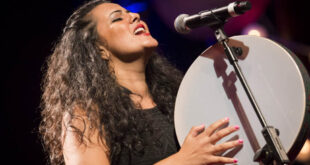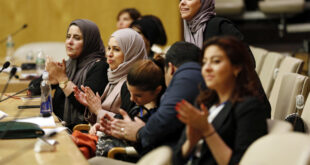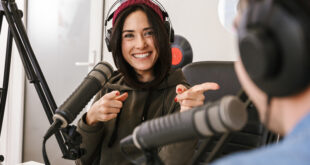BEIRUT -- A visual orgy. A human tsunami. A numbers game. Observers ran out of labels to describe Lebanon's made-for-TV intifada against a three-decade Syrian presence and attempts to counter it by Damascus' allies.
In a bid to sway public opinion for or against the government and its Syrian patron, a battle of visuals, symbols, and slogans swept Lebanese media following the seismic February 14 assassination of former premier Rafiq al-Hariri. Never had cameras in Lebanon been overwhelmed by such a sea of flags, signs, and other manifestations of popular uprising and counter-measures, as pro-Syrian supporters engaged the opposition in what quickly became a game of media one-upmanship.
The Numbers Game
The massive "Lebanon Spring" demonstration on March 14, 2005 capped a month of rallies by the opposition, calling for complete withdrawal of Syrian troops and Syrian intelligence services from the country and resignation of key intelligence and security officials in Lebanon whom the opposition held responsible for al-Hariri's death. Encouraged by TV coverage of earlier peaceful demonstrations, Lebanese émigrés even flew back to participate in the event.
Key TV stations had already provided near-blanket coverage for weeks as hundreds of thousands of protesters demanded freedom from Syrian tutelage and the truth about Hariri's brutal murder in unprecedented rallies in Beirut's Martyrs' Square and around the ex-prime minister's grave.
While Western media dubbed the uprising the "Cedar Revolution," in reference to the national emblem on Lebanon's flag, analysts cautioned that Lebanon was not Ukraine or Georgia and that color-coded clichés didn't fit the genuine home-grown revolt.
As Lebanese turned to their own media to make sense of the historic moment their country was experiencing, they had a choice of channels offering competing interpretations, coverage, and analyses. Nielsen, the TV ratings company, would have been stumped to measure Lebanese viewership following the Valentine's Day massacre given the speed with which many viewers zapped from channel to channel to watch news, analyses, talk shows, and massive pro- or anti-government/Syria rallies.
Lebanon's Lebanese Broadcasting Corporation International (LBCI) TV gave up the lion's share of its advertising revenue to dispatch its satellite and ground news teams to cover all related events. The original founder of LBCI was the outlawed Christian Lebanese Forces militia that thrived during Lebanon's 15-year civil war, but the station has since become the property of a group of businessmen including Pierre El-Daher, Najib Mikati, Issam Fares, and Saudi Arabia's Prince al-Walid bin Talal.
Hariri-owned Future TV (FTV), spearheading the opposition's advocacy of an international inquiry into the blast that left 18 other people dead and dozens wounded, has since February14 focused its programming on al-Hariri's life and accomplishments, shedding its commercially successful entertainment shows to pursue the new mission. Future TV was founded by Rafiq al-Hariri's family and is considered a Sunni stronghold, but has become the voice of pro-democracy activism during the recent crisis.
New TV (NTV) and Arabic News Broadcast (ANB), relative newcomers to the local/regional scene, played a respectable second string to the more established LBCI and FTV in providing live coverage from the early hours of the March 14 rally. Backed by Christian and Muslim entrepreneurs, ANB is considered pro-democracy, while NTV was founded by a former al-Hariri rival and Sunni from the same southern port city of Sidon. Following the former premier's death, however, the latter moderated his tone.

The two stations had played up pro-Syrian sentiments during a massive rally organized by Hizbullah a week earlier in nearby Riad Solh Square and reported that the crowds at that event totaled up to 1.5 million, a figure that was disputed by the opposition. The two channels also focused on a pro-Syrian rally in the southern town of Nabatiyeh. Numbers and visuals there paled, however, when compared to the opposition's media-savvy organization, whose logistics were handled in part by PR and advertising experts.
LBCI and FTV, for their part, had limited the number of hours dedicated to airing the pro-Syrian show of force. Future TV and Al Manar were on opposite ends of the seesaw with FTV reporting that the Beirut rally's numbers were beefed up by Syrians bussed in the night before -- something Al Manar denied.
Crowds drove to Beirut on March 14 from across the country, while cameras on highways and buildings recorded the event. When roadblocks initially blocked all vehicles, protesters walked. When stumped by traffic, residents of coastal towns rented fishing boats to reach the capital. It was Reality TV meets Hollywood epic.
Opposition forces, which had been mocked for their alleged foreign allegiances, were not to be upstaged. They mustered over a million followers in Martyrs' Square, with spillover into Riad Solh and every street feeding into them. In a country of about four million, it was an audiovisual victory par excellence. "Spring comes a week early," trumpeted LBCI, adding that the Lebanese calendar had changed numbers.
Most channels used split screens to show crowds converging on Martyrs' Square via Riad Solh, where the earlier Hizbullah gathering took place. The panoramic scenes from cameras perched atop buildings and tower cranes in downtown Beirut were gripping.
Critics later accused anchors and reporters of allegedly reflecting partisanship in their commentaries. Traditionally Christian media were tagged for zeroing in on pro-Christian demonstrators while Muslim-owned stations were said to have veered toward Syria.
The climactic March 14 event came on the heels of a weekend chock full of visual symbolism and photo opportunities. Over 10,000 people formed a human Lebanese flag in Martyrs' Square on March 12 by holding up color-coded cards in red, white, and green. The following evening thousands held a candlelight vigil in the same spot and created the words "The Truth" in Arabic and English, demanding that al-Hariri's assassins be brought to justice.
The World Watches
Meanwhile, US officials' chorus of support for freedom and democracy, echoed by European and international demands for implementation of UN Resolution 1559 that Syrian troops leave Lebanon without delay and Hizbullah be disarmed, added to the frenzy as world media turned their attention to the unfolding story.
A historic milestone was crossed February 28 when opposition legislators launched tirades against the government in an incendiary parliamentary session carried live by local, Arab and international satellite channels. Although the prime minister had earlier said he would secure a vote of confidence, he stunned the chamber and cheering crowds outside by submitting his resignation on-camera.
NBN showed only the parliamentary session, almost ignoring the long noisy rally outside. Equally absent in most coverage was state-run Tele-Liban, which seemed set on another planet.
Other channels had a field day with the deliberations inside.
Trauma at FTV
FTV journalists could not hold back tears on learning that al-Hariri had been brutally murdered, presumably in a bid to silence him and others contemplating criticism of the country's ruling elite and their backers.

FTV seemed hesitant and reluctant at first to air news of the patron's injury, or worse, his demise. It was too incredulous.
When the painful truth sank in, it was an endless rerun of the grisly charred corpses, fires being put out in still burning vehicles of the ex-premier's motorcade, dazed onlookers recounting what they had heard, seen and felt, and footage of al-Hariri just hours earlier in parliament or stopping at a downtown café.
Predictably, for FTV, Hariri became a "martyr" for Lebanon, a term all other media soon used to describe him and members of his entourage who perished in the blast.
Ironically, the attack occurred on the eve of FTV's twelfth anniversary. The following day on-air reporters and anchors were clad in black and appeared without makeup. A black strip cut across the station's blue logo.
When FTV reporters, editors, anchors and producers finally came to grips with the reality, there was a mad scramble to dig up archival footage of al-Hariri in parliament, with his family, visiting construction sites in downtown Beirut (which he is largely credited with having rebuilt after the war), as a devout Muslim visiting the holy sites in Saudi Arabia, and replays of interviews he had granted foreign media.
Differing Views from the Scene
By then most local, Arab, and foreign TV channels had jumped into the fray and were jostling for air time, uplinks on different "birds," positioning themselves on buildings to capture different angles of the crime scene, fighting the crowds that gathered in front of and inside the American University Hospital where al-Hariri and his companions were taken and seeking "talking heads" to interview or from whom to solicit analyses about the earth-shattering event.
Lebanon's NTV scored a scoop with scenes of al-Hariri's private medic in a futile attempt to stay alive while his body was in flames as he made his way out of a burning vehicle. The footage was rebroadcast by Arab and Western channels.
NTV's founder had long been opposed to al-Hariri but his station's position was professional and non-confrontational during coverage of the subsequent condolences at the Hariri residence, the funeral and burial, and, the daily vigils around his grave, which turned into a shrine.
LBCI was also among the first at the blast scene with breathtaking footage of charred remains and eyewitness reports. It was a throwback to Lebanon's dark civil war days. "Christian" LBCI TV even aired verses from the Koran, which radio and TV stations traditionally broadcast in Arab countries at the death of a leader.

Even Hizbullah's Al Manar and the largely Maronite church-financed Télé-Lumiere joined in the national outpouring of grief and provided comprehensive coverage of the event.
Despite these different takes, Lebanon's media exercised a modicum of responsibility and maturity rarely seen during the preceding months of political mudslinging and finger pointing in the run-up to May's parliamentary elections.
This was in sharp contrast to Qatar's Al Jazeera TV which viewers slammed for repeatedly airing a seemingly fabricated tape by a self-styled Islamist who claimed responsibility for al-Hariri's death. Other stations had broadcast the tape but were more skeptical about its veracity.
Bashar's Video Moment
One particularly strange juxtaposition occurred March 5, when Lebanese flag wavers by the tens of thousands converged on Martyrs' Square calling for immediate Syrian troop withdrawal from their country while Syrian cheerleaders with their flags, egged on by apparatchiks, massed outside parliament in Damascus to support their leader's next moves.
LBCI TV aired Syrian president Bashar al-Asad's address to parliament announcing he would redeploy troops to the Syrian border, minus a fixed timetable and specification on which side of the frontier they would remain.
It also showed split-screen footage of thrilled crowds watching on giant monitors set up in Beirut's newly-named "Freedom Square" demanding that the pullout be complete and that it include countless security and intelligence operatives. The media themselves were becoming part of the story.
History Being Made
Analysts agreed that events imposed themselves on the media, which could only embrace the inevitable coverage. Lebanon, with its long history of vibrant and free media (compared to other Arab countries), may be regaining its rightful place following years of Syrian meddling and competition from pan-Arab outlets in the Gulf.
The heady days of recent political events have, once again, brought Lebanese media to prominence and are bound to have an impact on their regional counterparts.
Once the flag waving subsides, it will be interesting to see if Lebanon's TV channels blaze a new trail for media freedom.
| Slogans raised or voiced during pro-democracy rallies
- This crowd made in Lebanon |
 Arab Media & Society The Arab Media Hub
Arab Media & Society The Arab Media Hub




